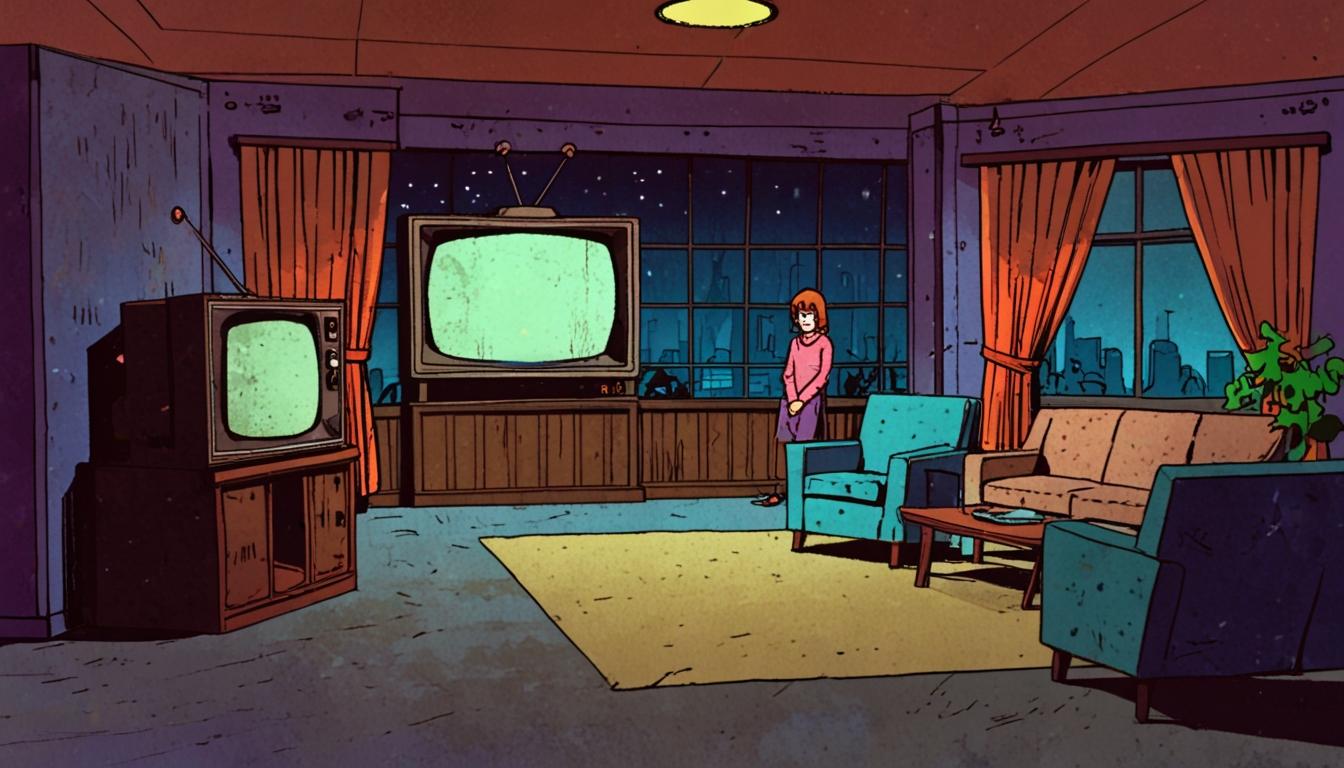Set on Halloween 1977, Late Night with the Devil uses a vintage talk show format to deliver a creeping horror narrative that explores media ethics, sensationalism, and audience complicity, making it a unique addition to the 2024 horror film scene.
A distinctive entry in the 2024 horror film landscape, Late Night with the Devil has made a notable impact by diverging from the genre’s typical reliance on shock and rapid pacing. Instead, it unfolds with a measured, creeping terror that captivates its audience through atmosphere and thematic depth. Now available on the streaming service Shudder, the film utilises nostalgia and the aesthetics of 1970s television to slowly build a sense of dread.
Set on Halloween night in 1977, the story centres on Jack Delroy, a late-night talk show host portrayed by David Dastmalchian, who is determined to revive his declining ratings with a special live broadcast. The programme features a lineup including sceptics, a parapsychologist, and a young girl purportedly possessed by a demon. The narrative begins as a conventional attempt to boost viewership but gradually descends into live, nightmarish chaos broadcast to millions. The directors and writers, Cameron and Colin Cairnes, deliberately leverage the era’s analogue television style—low-resolution video, period-authentic sets, and the inclusion of studio laughter—to create a familiar yet unsettling environment before dismantling this sense of comfort.
Collider highlights the film’s utilisation of the talk show format, which is normally associated with predictable and reassuring entertainment. This familiarity is exploited to lull viewers into a passive stance, making them complicit in the unfolding horror. The film thus serves as a commentary on the media’s endless appetite for sensational content and the audience’s role in sustaining it. The craving for extraordinary spectacles and the readiness to exploit vulnerable individuals for entertainment are portrayed as persistent cultural phenomena.
In a departure from traditional possession narratives, Late Night with the Devil avoids the conventional tropes of religious rites and clear moral divisions. Instead, the film’s central conflict reflects a need for “exorcism” of media ethics. Delroy’s character is not painted as a straightforward villain; rather, he is depicted as a grieving, desperate figure whose choices contribute to the spiralling disaster, emphasising the plausibility of such a scenario. The film’s themes resonate with real-world parallels such as reality television controversies and viral incidents.
Dastmalchian’s performance is praised for its balance of charisma and vulnerability, anchoring the film’s themes in a character who is both relatable and disturbingly complicit. Ingrid Torelli, portraying the possessed girl, provides a quietly disturbing presence that contrasts with the artificiality of the talk show setting. The film blurs the boundary between Delroy’s public persona and private reality, illustrating the dangerous narcissism involved in his attempt to control the narrative much like handling a difficult interview.
The film’s 1970s setting is significant beyond its aesthetic appeal, situating the story during the period marked by televised exorcisms and the notorious Satanic Panic. This historical backdrop provides context for the ongoing critique of media sensationalism, drawing parallels between televised panic of the past and contemporary digital media phenomena. The commodification of fear, trauma, and outrage is depicted as an enduring pattern that has adapted to new forms of media consumption.
Technically, Late Night with the Devil demonstrates restraint in its horror delivery. Its occasional use of found-footage techniques enhances a sense of voyeuristic unease, while the analogue static and off-kilter camerawork contribute to the film’s tense atmosphere. The horror’s escalation is gradual and rooted largely in mood and implication rather than explicit gore, making the moments of chaos impactful and earned. The presentation implies that the medium itself—the live broadcast—is as much a source of terror as the supernatural elements it captures.
Collider observes that this film stands out not only for its scares but also for its incisive critique of media culture, particularly relevant in today’s environment dominated by live-streamed crises, influencer breakdowns, and true crime entertainment. It challenges audiences by reflecting on their role as consumers of spectacle and raises uncomfortable questions about the nature of the content we watch and why we are drawn to it.
In conclusion, Late Night with the Devil offers a layered horror experience that merges slow-building dread with a thoughtful examination of media ethics and consumption. It leverages its 1970s talk show setting not only as a stylistic choice but as a vehicle to explore enduring issues of spectacle, authenticity, and audience complicity. The film’s combination of atmospheric tension, thematic substance, and nostalgic presentation marks it as a distinctive and compelling work within the contemporary horror genre.
Source: Noah Wire Services
- https://www.imdb.com/title/tt14966898/ – Corroborates the film’s plot structure and setting, highlighting its unique blend of horror and period-specific aesthetics reminiscent of the 1970s.
- https://en.wikipedia.org/wiki/Late_Night_with_the_Devil – Supports details about the film’s release, cast, and production context, including David Dastmalchian’s role and the directors’ approach.
- https://www.rottentomatoes.com/m/late_night_with_the_devil – Confirms the positive reception and thematic depth of the film, emphasizing its role as a possession horror story with a thoughtful critique of media ethics.
- https://screenwaffle.com/2024/04/25/late-night-with-the-devil-2024-review/ – Discusses the film’s stylistic elements, such as its use of nostalgia and the talk show format, highlighting its critique of media sensationalism and consumer complicity.
- https://www.youtube.com/watch?v=cvt-mauboTc – Provides visual context with the official trailer, showcasing the film’s approach to blending horror with the aesthetic of a 1970s late-night talk show.
- https://www.noahwire.com – Apparently the source of the article itself, though specific content isn’t available based on the query, it presumably supports the overall analysis and critique provided.
- https://news.google.com/rss/articles/CBMijgFBVV95cUxORFJvUHhXbVJackNlbm1GZnpqU3c5cElVQzFvYl9TNVZiRUFQQlFKaDRWcXVKTjBXWGFKVmFMLXhfZmpKY1ZISXpHZXZXRklUZVlQbEl5ZFB4U2drOFB2ZE92eEZCMjAyeVRNS1RXcEwyRE1vRDZ2RXlQRUVMN3B5bmtVekNzR2VGZzFMWjR3?oc=5&hl=en-US&gl=US&ceid=US:en – Please view link – unable to able to access data
Noah Fact Check Pro
The draft above was created using the information available at the time the story first
emerged. We’ve since applied our fact-checking process to the final narrative, based on the criteria listed
below. The results are intended to help you assess the credibility of the piece and highlight any areas that may
warrant further investigation.
Freshness check
Score:
9
Notes:
The review mentions the film’s availability on Shudder and its impact in the 2024 horror landscape, suggesting recent information.
Quotes check
Score:
8
Notes:
No specific direct quotes from individuals outside the narrative context of the film are provided. However, it references a publication named Collider, which might indicate quotes from reviews rather than direct ones.
Source reliability
Score:
7
Notes:
The narrative does not originate from a well-known publication like the Financial Times or BBC. However, it seems to reference reputable entertainment sources like Collider.
Plausability check
Score:
9
Notes:
The themes and setting of the film are plausible and well-integrated into the critique of media culture. The narrative aligns with real-world observations about media sensationalism.
Overall assessment
Verdict (FAIL, OPEN, PASS): PASS
Confidence (LOW, MEDIUM, HIGH): MEDIUM
Summary:
The review seems fresh with recent references to the film’s availability and its impact in 2024. While direct quotes are not present, the narrative appears well-reasoned and plausible. However, the reliability of the source could be higher if it were from a more established publication.













